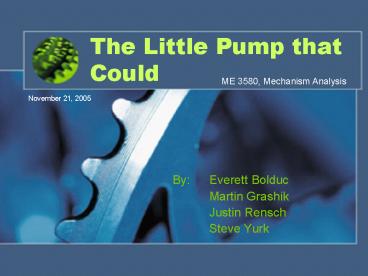The Little Pump that Could PowerPoint PPT Presentation
1 / 12
Title: The Little Pump that Could
1
The Little Pump that Could
ME 3580, Mechanism Analysis
November 21, 2005
- By Everett Bolduc
- Martin Grashik
- Justin Rensch
- Steve Yurk
2
Abstract
- The oil pump is a simple mechanism that
oscillates up and down to draw oil out of the
ground. The task of this project was to analyze
the oil pump, find the degrees of freedom, and do
a position, velocity, and acceleration analysis
on it. We first identified the mechanism as a
four-bar linkage, defined critical parameters and
dimensions, then applied the appropriate
equations.
3
Introduction
- Use of Mechanism
- The objective of the oil field pump is to
convert the circular motor input into a smooth
oscillatory rocking motion that can be utilized
to draw crude oil out of the ground. To achieve
this motion the pump uses a four bar system
consisting of ground, a crank, pitman arm, and a
balance beam. The balance beam can be adjusted
with weights to reach the most efficient
oscillatory motion that will also have the least
wear on the motor.
- Critical Parameters
- Some critical parameters that should be
consider for the oil field pump are the frequency
of the rocking motion, proper weight and balance,
and thus position of the links, and also the
dimensions of the links to insure proper
amplitude of motion. All of these parameters need
to be defined to produce the needed pressure to
pump the oil, and to have the least amount of
strain and energy input to the motor. An analysis
of the oil field pump will help define
quantitatively what these critical parameters
are.
4
Drawing of Mechanism
Dimensions in inches
5
Degrees of Freedom
from Greublers Equation
Mobility 3L 2J 3G Where L of Links,
J Number of Joints, G Number of ground
Links M 3(4) - 2(4) - 3(1) 12 8 3
1 D.O.F. 1
6
Position Analysis
Analytical
All angles in radians
7
Position Analysis
Graphical
?2 327 5.707rad ?3 -33 -0.576rad
?4 269 4.695rad -1.588rad ?P 71
1.239rad
8
Velocity Analysis
9
Acceleration Analysis
10
Results
- To obtain values for the positions, velocities
and accelerations we used the equations from the
Design of Machinery textbook, programmed into
Microsoft Excel. - A rough drawing in and graphs from Working Model
2D are shown at right for the motion of point P
(shown in the drawing) - The motion is oscillatory between two extreme
values.
11
Conclusion and Recommendations
The amplitude of point P was found to be 27.12
inches, or about 2 feet. This seems like a
reasonable pumping distance per revolution of the
crank arm because you dont want to have the
engine pulling up too much oil per revolution.
This parameter can not be too large since the
pumping amplitude is directly related to the
volume of oil pumped. One recommendation we could
offer would be to keep the center of gravity of
the rocker arm directly above the support
(designated point D on the AutoCAD drawing).
This would create less wear and tear on the
engine by making it easier for the coupler to
push the rocker up and down.
12
Resources
- AutoCAD 2006. San Rafael, CA Autodesk Inc.
(2006) - Norton R. L. (2004) Design of machinery, Third
Edition, McGraw-Hill, New York. - Working Model 2D. Santa Ana, CA MSC. Software
Corp. (2005). - Microsoft Office PowerPoint. Redmond, WA
Microsoft Corp. (2003). - Microsoft Office Excel Redmond, WA Microsoft
Corp. (2003).

